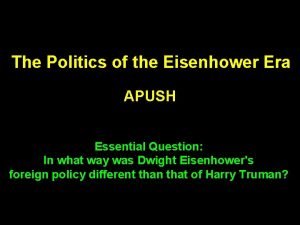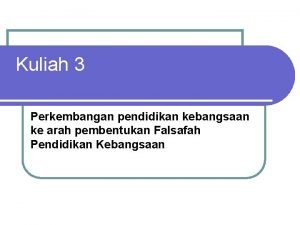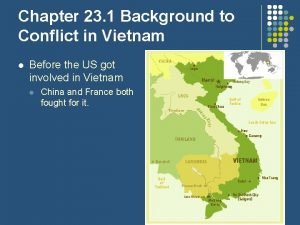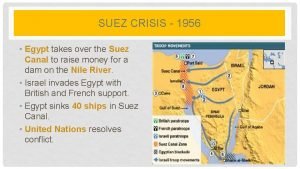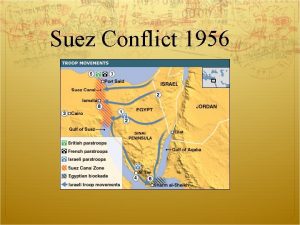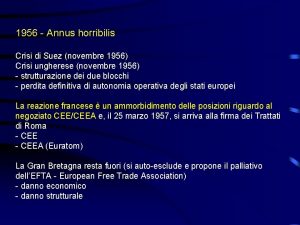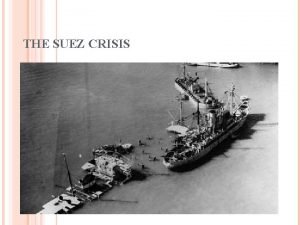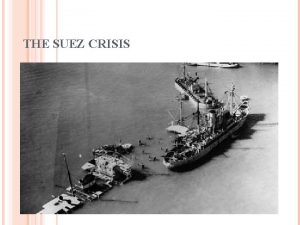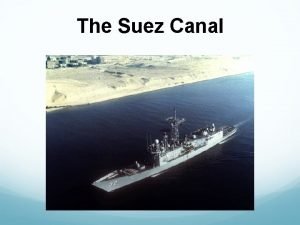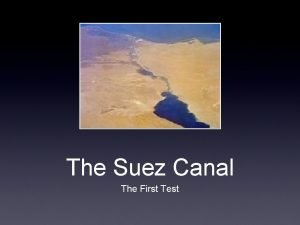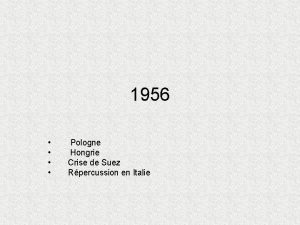The Suez Crisis 1956 John Foster Dulles US
















- Slides: 16

The Suez Crisis, 1956 John Foster Dulles (US Secretary of State 1953 -59), Anthony Eden (UK Prime Minister 1955 -57) and Guy Mollet (French Prime Minister 1956 -57)

A view of the Middle East prior to the crisis in March 1956

• Cartoon reminding Britain and France of the UN on the verge of the Suez Crisis, August 10 th 1956.

• A view of the Middle East at the start of the crisis on October 31 st 1956

Location and history of the Suez canal • Suez Canal opened to traffic in November 1869. • It was built by Frenchman Ferdinand de Lesseps using Egyptian forced labour; an estimated 120, 000 workers died during construction. • It stretches 192 km (120 miles) between the Mediterranean and the Red Sea. • It is 300 m (984 ft) wide at its narrowest point. • By 1955 approximately twothirds of Europe's oil passed through the canal.

Chronology of the Suez Crisis • 1. 29 October: Israeli paratroops dropped east of town of Suez • 2. 30 October: More paratroops dropped to the east of Mitla Pass. Troops begin crossing the border at Qussaima. • 3. 31 October: British bombs dropped on Cairo and Cairo international airport • 4. 2 November: Israeli paratroops land near Al Tor, west of Sinai • 5. 5 November: British paratroops land west of Port Said. French paratroops land south of Port Said • 6. 5 November: Israelis capture Sharm al. Sheikh to lift blockade of Gulf of Aqaba. • 7. 6 November: Anglo-French invasion force bombardment and landings • 8. 7 November: Anglo-French forces claim to have occupied most of the Suez Canal zone as far as Ismailia, when UN orders a halt to fighting 21 November: First UN troops land at Port Said 23 November: British and French forces begin withdrawal from Egypt 22 December: Withdrawal completed at midnight

Context of the Crisis • The defeat of Egypt in the war against Israel was a catalyst that led the Egyptian army to overthrow the monarchy of King Farouk. • Gamal Abdel Nasser and his fellow army officers were appalled at the incompetence of the Egyptian government and overthrew it in 1952. • In order to establish Egyptian independence they wanted to remove the British troops stationed at the Suez Canal.

• Britain and Egypt signed the Suez Canal Agreement, in 1954 whereby all British troops were to be withdrawn from Egypt by June, 1956.

1955: US/UK Funding for Aswan Dam • In December 1955, the US and UK pledged $56 million and $14 million respectively towards the construction of the High Aswan Dam (construction began in 1960, the dam was opened in 1964 and the reservoir reached capacity in 1976). • However on July 19 th 1956, rescinded its offer and this drove Egypt into an alliance with the USSR and contributed to the Suez Crisis.


1956: Nationalization • In July 1956, the last British soldiers pulled out of the canal zone. On July 26 th, Nasser abruptly announced the nationalisation of the Suez Canal Company. • Nasser's nationalisation of the canal was followed by intensive diplomatic activity, supposedly aimed at establishing some kind of international control of the strategically vital waterway (which Nasser denounced). It turned out to be a smokescreen for military preparations.

The unfolding drama • British and French troops, spearheaded by airborne forces, invaded the canal zone on October 31. • Their governments told an outraged world that they had to invade, to separate Egyptian and Israeli forces, and thus protect the freedom of navigation on the canal. • The reality was that the British and French, in top secret negotiations with Israel had forged an agreement for joint military operations. • Israel, in fact, had the most legitimate grievance of the three invaders, for since the establishment of the Jewish state in 1948, Egypt had denied passage through the canal to any Israeli-flagged or Israel-bound ships.

• Israeli forces swept into the Sinai desert on September 29, two days before the Anglo. French invasion, and raced towards the canal. (One column was headed by a young brigade commander who would go on to become Prime Minister: Ariel Sharon). • In less than seven days, the entire Sinai peninsula was in Israeli hands.

Ceasefire • The Anglo-French invasion was a good deal more ignominious. Just eight days after the first airborne lands, the operation was halted under a ceasefire ostensibly ordered by the United Nations, but in fact dictated by the Americans. The Egyptian air force had been destroyed and its army mauled. • Under Nasser's orders, 47 ships were scuttled in the waterway and the Suez canal was totally blocked.

Soviet Response • The Soviet Union and its allies, were given a glorious opportunity to attack western imperialism (and deflect world attention from their own brutality in crushing the simultaneous Hungarian uprising).

US Response • Washington was appalled by the Anglo-French. Israeli invasion of the canal zone and the Sinai. • The action threatened to destabilise the strategically vital region, and strengthen Soviet links with liberation movements around the world. • It raised global tensions in an age dominated by the nuclear arms race and recurring superpower crises. More viscerally, it was viewed with distaste as a nakedly imperial exercise in a postimperial age.
 Dwight eisenhower apush
Dwight eisenhower apush Slidetodoc.com
Slidetodoc.com Church structure models
Church structure models Washington flyer cab
Washington flyer cab Models of revelation
Models of revelation Acetylcholine crisis
Acetylcholine crisis Chafee foster care program
Chafee foster care program Historia telefonu
Historia telefonu Pista disco duro
Pista disco duro The golden age (1939-1956)
The golden age (1939-1956) 1956 vietnam
1956 vietnam The ten commandments 1956
The ten commandments 1956 Korean police
Korean police Zlota z melbourne 1956 r
Zlota z melbourne 1956 r Dasar pendidikan kebangsaan sebelum merdeka
Dasar pendidikan kebangsaan sebelum merdeka Hiver 1956
Hiver 1956 1956 vietnam
1956 vietnam
